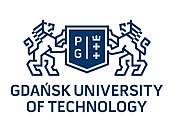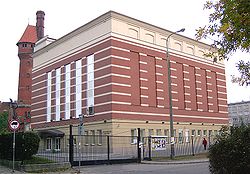Technical University of Gdansk
| Technical University of Gdansk | |
|---|---|

|
|
| motto | Historia mądrością - przyszłość wyzwaniem (English: History is wisdom - future is challenge , German: History is wisdom - future is challenge ) |
| founding | October 6, 1904 |
| Sponsorship | state |
| place | Gdansk , Poland |
| Rector | Kszysztof Wilde |
| Students | 20,000 |
| Website | Politechnika Gdańska |
The Technical University of Gdansk (Polish Politechnika Gdańska ) is a technical university in Gdansk .
History until 1945
The Royal Prussian Technical University of Danzig was founded in 1904 by the Prussian Ministry of Spiritual, Educational and Medical Matters with the support of the Natural Research Society in Danzig based on an idea by Gustav von Goßler . It was intended to promote training in technical disciplines in Gdansk, the Province of Pomerania and the Province of West Prussia . East Prussia had a university for a long time with the Albertus University in Königsberg , "naturally" without a technical orientation.
246 students began their training in the buildings designed by Albert Carsten in the Faculties of Architecture , Civil Engineering , Mechanical Engineering , Electrical Engineering , Shipbuilding , Chemistry and General Sciences.
In particular, the teaching in urban planning in Danzig was occupied by well-known professors: the chair for urban planning was occupied by Ewald Genzmer (1904–1911) from the establishment of the University of Applied Sciences; he was followed by Friedrich Gerlach (1911–1926) and from 1927 to 1945 Karl August Hoepfner . The chair for medieval architecture was held by Friedrich Ostendorf from 1904 to 1907 ; he was followed by Karl Gruber from 1925 to 1933 . From 1912 the chair for building construction and urban planning was represented by Otto Kloeppel until 1939 .
After the First World War , Danzig was separated from the Free State of Prussia as the Free City of Danzig in 1920 . The university continued its work as a technical university. The League of Nations and the Second Polish Republic exerted influence, which the locals resisted.
In 1925 the Danzig University - “praised as good and not particularly easy in the Reich” - had 1,600 students, 1,000 of them in the German student body , 400 Poles (from the Polish Corridor ) as well as Yugoslavs, Swedes, Russians, Norwegians, Greeks and others. Only German was spoken in the lectures and exams. The lecturers and assistants as well as the lecturer for the Polish language were German. Poles and Germans ignored each other. Only the German student body appeared at official events.
The Polish student body was also self-contained, partly in colored student associations . The League of Nations had assigned her to a former German barracks, which she had set up as a student residence and casino. The Germans had "their" Hagelsberg , part of the earlier city fortifications between Danzig and Langfuhr. Student apartments and many bars were built into the corridors and vaults of the meter-thick fortress walls. The Danzig Senior Citizens' Convention also lived there . The economic and welfare institutions of the German student body were housed in barracks on the university campus. They had 500–600 laundry customers and 600–700 lunch customers.
After the invasion of Poland in 1941, the university became a state institution of the German Reich again . The building also served as a hospital . In January 1945, documents from the Danzig universities were to be brought to West Germany with the Wilhelm Gustloff . They went down with her.
History from 1945
On May 24, 1945, the Polish government enacted a decree that transformed the university into today's State Technical University. The new university became a large institution in terms of its number of employees and students: today it is the largest university of its kind in northern Poland and one of the largest in Poland. The Technical University of Gdansk has full academic rights, including doctorate and habilitation rights. It has a high national and international reputation as an important center of science. International conferences held at the Technical University of Gdańsk offer the opportunity for an excellent scientific and personal exchange of ideas.
List of rectors since 1904
Trivia
The novel Castorp by Paweł Huelle is based on a sentence from the novel The Magic Mountain by Thomas Mann : "At that time he had spent four semesters studying at the Danzig Polytechnic ...". Huelles novel describes the studies at the newly founded university, life in Gdansk, the political background and the personal fate of Castorp, especially in the first two semesters.
literature
- House and Landowners Association Gdansk (ed.): Gdansk and its new technical college . 1904 ( digitized version (full text) ).
- Jerzy Serczyk: The higher education system in northern Poland (the former East and West Prussia) after 1945 , in: Udo Arnold (ed.): Prussia as a university landscape in the 19th and 20th centuries. Century . Nordostdeutsches Kulturwerk, Lüneburg 1992, pp. 151–169.
Web links
- Homepage
- Short Outline of History Gdansk University of Technology in the years 1904 - 1945 ( Memento from July 17, 2006 in the Internet Archive )
- TH Danzig ( Memento from October 14, 2004 in the Internet Archive )
Individual evidence
- ↑ https://pg.edu.pl/rector-and-vice-rectors
- ↑ a b Corps-Zeitung of Borussia Breslau, 14th year (1927), issue 27, p. 738 f.
- ^ Rector's speeches in the 19th and 20th centuries - online bibliography: Royal Technical University of Danzig. Historical commission at the Bavarian Academy of Sciences, accessed on June 6, 2020 .
Coordinates: 54 ° 22 ′ 17 ″ N , 18 ° 37 ′ 8 ″ E


